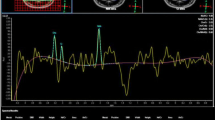Abstract
Our purpose was to investigate whether in vivo proton magnetic resonance spectroscopic imaging, using normalized concentrations of total choline (tCho) and total creatine (tCr), can differentiate between WHO grade I pilocytic astrocytoma (PA) and diffuse, fibrillary WHO grade II astrocytoma (DA) in children. Data from 16 children with astrocytomas (11 children with PA and 5 children with DA) were evaluated retrospectively. MRS was performed before treatment in all patients with histologically proven low-grade astrocytomas. Metabolite concentrations of tCho and tCr were normalized to the respective concentration in contralateral brain tissue. The Mann-Whitney U test was performed to evaluate differences between these two groups. Normalized tCho did not show any statistically significant difference between the two groups. There was a strong trend (P = 0.07) toward higher values of normalized tCr in the DA group. For 3 of 5 children with DA, lactate was detectable, but only 1 of 11 children with PA showed lactate. We concluded that choline as a single parameter is not reliable in the differential diagnosis of low-grade astrocytomas in children. Our results suggest that tCr concentrations combined with lactate will be helpful in the differential diagnosis of PA and DA in children.
Similar content being viewed by others
References
Louis DN, Ohgaki H, Wiestler OD, et al (2007) The 2007 WHO classification of tumors of the central nervous system. Acta Neuropathol 114(2):97–109
Broniscer A, Baker SJ, West AN, et al (2007) Clinical and molecular characteristics of malignant transformation of low-grade glioma in children. J Clin Oncol 25:682–689
Fisher PG, Tihan T, Goldthwaite PT, et al (2008) Outcome analysis of childhood low-grade astrocytomas. Pediatr Blood Cancer 51:245–250
Ohgaki H, Eibl RH, Schwab M, et al (1993) Mutations of the p53 tumor suppressor gene in neoplasms of the human nervous system. Mol Carcinog 8:74–80
von Deimling A, Louis DN, Menon AG, et al (1993) Deletions on the long arm of chromosome 17 in pilocytic astrocytoma Acta Neuropathol 86:81–85
Davies NP, Wilson M, Harris LM, et al (2008) Identification and characterisation of childhood cerebellar tumors by in vivo proton MRS. NMR Biomed 21:908–918
Tzika AA (2008) Proton magnetic resonance spectroscopic imaging as a cancer biomarker for paediatric brain tumors (Review). Int J Oncol 32:517–526
Panigrahy A, Krieger MD, Gonzalez-Gomez I, et al (2006) Quantitative short echo time 1H-MR spectroscopy of untreated paediatric brain tumors: preoperative diagnosis and characterization. AJNR Am J Neuroradiol 27:560–572
Lazareff JA, Bockhorst KH, Curran J, et al (1998) Paediatric lowgrade gliomas: prognosis with proton magnetic resonance spectroscopic imaging. Neurosurgery 43:809–817
Hwang JH, Egnaczyk GF, Ballard E, et al (1998) Proton MR spectroscopic characteristics of paediatric pilocytic astrocytomas. AJNR Am J Neuroradiol 19:535–540
Sutton LN, Wang Z, Gusnard D, et al (1992) Proton magnetic resonance spectroscopy of paediatric brain tumors. Neurosurgery 31:195–202
Wang Z, Sutton LN, Cnaan A, et al (1995) Proton MR spectroscopy of paediatric cerebellar tumors. AJNR Am J Neuroradiol 16:1821–1833
Sutton LN, Wehrli SL, Gennarelli L, et al (1994) High-resolution 1H magnetic resonance spectroscopy of paediatric posterior fossa tumors in vitro. J Neurosurg 81:443–448
Harris LM, Davies NP, Macpherson L, et al (2008) Magnetic resonance spectroscopy in the assessment of pilocytic astrocytomas. Eur J Cancer 44:2640–2647
Astrakas LG, Zurakowski D, Tzika AA, et al (2004) Noninvasive magnetic resonance spectroscopic imaging biomarkers to predict the clinical grade of paediatric brain tumors. Clin Cancer Res 10:8220–8228
Murphy PS, Leach MO, Rowland IJ (1999) Signal modulation in 1H magnetic resonance spectroscopy using contrast agents: proton relaxivities of choline, creatine, and N-acetylaspartate. Magn Reson Med 42:1155–1188
Hattingen E, Raab P, Franz K, et al (2008) Myo-inositol: a marker of reactive astrogliosis in glial tumors. NMR Biomed 21:233–241
Provencher SW (1993) Estimation of metabolite concentrations from localized in vivo proton NMR spectra. Magn Reson Med 30:672–679
Hattingen E, Raab P, Franz K, et al (2008) Prognostic value of choline and creatine in WHO grade II gliomas. Neuroradiology 50:759–767
Tedeschi G, Lundbom N, Raman R, et al (1997) Increased choline signal coinciding with malignant degeneration of cerebral gliomas: a serial proton magnetic resonance spectroscopy imaging study. J Neurosurg 87:516–524
Isobe T, Matsumura A, Anno I, et al (2002) Quantification of cerebral metabolites in glioma patients with proton MR spectroscopy using T2 relaxation time correction. Magn Reson Imaging 20:343–349
Howe FA, Barton SJ, Cudlip SA, et al (2003) Metabolic profiles of human brain tumors using quantitative in vivo 1H magnetic resonance spectroscopy. Magn Reson Med 49:223–232
Sutton LN, Wang ZJ, Wehrli SL, et al (1997) Proton spectroscopy of suprasellar tumors in paediatric patients. Neurosurgery 41:388–394
Shimizu H, Kumabe T, Shirane R, Yoshimoto T (2000) Correlation between choline level measured by proton MR spectroscopy and Ki-67 labeling index in gliomas. AJNR Am J Neuroradiol 21:659–665
Chen J, Huang SL, Li T, Chen XL (2006) In vivo research in astrocytoma cell proliferation with 1H-magnetic resonance spectroscopy: correlation with histopathology and immunohistochemistry. Neuroradiology 48:312–318
Tamiya T, Kinoshita K, Ono Y, et al (2000) Proton magnetic resonance spectroscopy reflects cellular proliferative activity in astrocytomas. Neuroradiology 42:333–338
Law M, Cha S, Knopp EA, et al (2002) High-grade gliomas and solitary metastases: differentiation by using perfusion and proton spectroscopic MR imaging. Radiology 222:715–721
Guillevin R, Menuel C, Duffau H, et al (2008) Proton magnetic resonance spectroscopy predicts proliferative activity in diffuse low-grade gliomas. J Neuro-Oncol 87:181–187
Author information
Authors and Affiliations
Corresponding author
Rights and permissions
About this article
Cite this article
Porto, L., Kieslich, M., Franz, K. et al. Proton magnetic resonance spectroscopic imaging in pediatric low-grade gliomas. Brain Tumor Pathol 27, 65–70 (2010). https://doi.org/10.1007/s10014-010-0268-6
Received:
Accepted:
Published:
Issue Date:
DOI: https://doi.org/10.1007/s10014-010-0268-6




